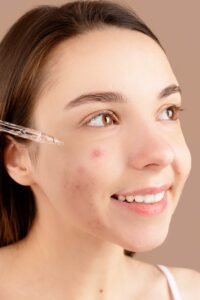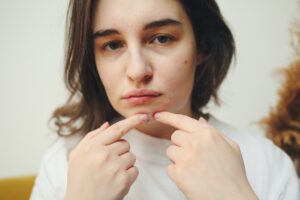Topical Treatments for Acne

Acne is a common skin condition that affects millions of people worldwide. It can be frustrating and embarrassing, but it’s important to understand that it’s a normal part of skin physiology. In this blog post, we’ll explore the causes of acne and the various treatment options available to help you manage and prevent breakouts.
What is Acne?
Acne is a skin condition that occurs when hair follicles become clogged with oil and dead skin cells. This can lead to the formation of pimples, blackheads, whiteheads, and even cysts. Acne typically affects the face, neck, chest, and back, and can be mild, moderate, or severe.
Causes of Acne
Acne is caused by a combination of factors, including genetics, hormones, and environmental factors. When oil and dead skin cells build up in the hair follicles, it creates an environment where bacteria can thrive. This can lead to inflammation, which causes the redness and swelling associated with acne.
Hormonal changes are a major contributor to acne, which is why teenagers often experience breakouts during puberty. Hormones can cause the sebaceous glands in the skin to produce more oil, which can clog pores and lead to breakouts.
Other factors that can contribute to acne include stress, diet, and certain medications. High levels of stress can cause hormonal imbalances that can trigger breakouts, while a diet high in sugar and processed foods can also contribute to acne. Some medications, such as corticosteroids and lithium, can also cause acne as a side effect.
Treatment Options for Acne
There are a variety of treatment options available to help manage and prevent acne breakouts. The type of treatment recommended will depend on the severity of your acne and the underlying cause.
Topical Treatments
Topical treatments are applied directly to the skin and are often the first line of defense against acne. There are several types of topical treatments available, including:
- Benzoyl Peroxide: Benzoyl peroxide is a powerful anti-bacterial agent that helps to unclog pores and reduce inflammation. It’s available over-the-counter in varying strengths and can be found in many acne treatments.
- Salicylic Acid: Salicylic acid is a beta-hydroxy acid that helps to exfoliate the skin and unclog pores. It’s often found in acne treatments and is gentle enough to be used daily.
- Retinoids: Retinoids are derived from vitamin A and are highly effective at reducing acne. They work by unclogging pores, reducing inflammation, and promoting cell turnover. Retinoids are available by prescription only and can cause skin irritation in some people.
Oral Medications
For more severe acne, oral medications may be necessary. These medications are taken by mouth and work by reducing inflammation, controlling hormones, and killing bacteria. The most common oral medications used to treat acne include:
- Antibiotics: Antibiotics are often used to kill bacteria that can contribute to acne. They’re typically taken for a few months and can help to reduce inflammation and prevent future breakouts.
- Hormonal Therapy: Hormonal therapy is often used to treat acne in women. This type of therapy works by regulating hormones that can contribute to acne breakouts.

Procedures
In addition to topical and oral treatments, there are also several procedures that can be used to treat acne. These procedures are typically performed by a dermatologist and include:
Chemical Peels
Chemical peels involve the application of a chemical solution to the skin, which causes the top layer of skin to peel off. This helps to unclog pores, reduce inflammation, and improve the appearance of acne scars. Chemical peels can be done in various strengths, depending on the severity of the acne and the patient’s skin type.
Microdermabrasion
Microdermabrasion is a procedure that involves the use of a device to exfoliate the top layer of skin. This helps to remove dead skin cells, unclog pores, and improve the appearance of acne scars. Microdermabrasion is generally a gentle treatment that can be used on all skin types.
Light Therapy
Light therapy involves the use of specific wavelengths of light to target the bacteria that cause acne. This helps to reduce inflammation and prevent new acne from forming. Light therapy can be done using either blue or red light, and can be done in-office or at home using a handheld device.
Laser Therapy
Laser therapy is a more intensive procedure that involves the use of a laser to target the bacteria that cause acne. This helps to reduce inflammation and prevent new acne from forming. Laser therapy can also be used to improve the appearance of acne scars.
Extraction
Extraction involves the manual removal of blackheads and whiteheads using a special tool. This procedure should only be done by a dermatologist or esthetician, as it can cause scarring and infection if not done properly.
Intralesional Corticosteroid Injections
Intralesional corticosteroid injections involve the injection of a corticosteroid directly into a large, painful acne cyst. This helps to reduce inflammation and pain, and can speed up the healing process. This procedure should only be done by a dermatologist.
It is important to note that while these procedures can be effective in treating acne, they may also come with side effects and risks. It is important to discuss all options and potential risks with a dermatologist before undergoing any procedure.

